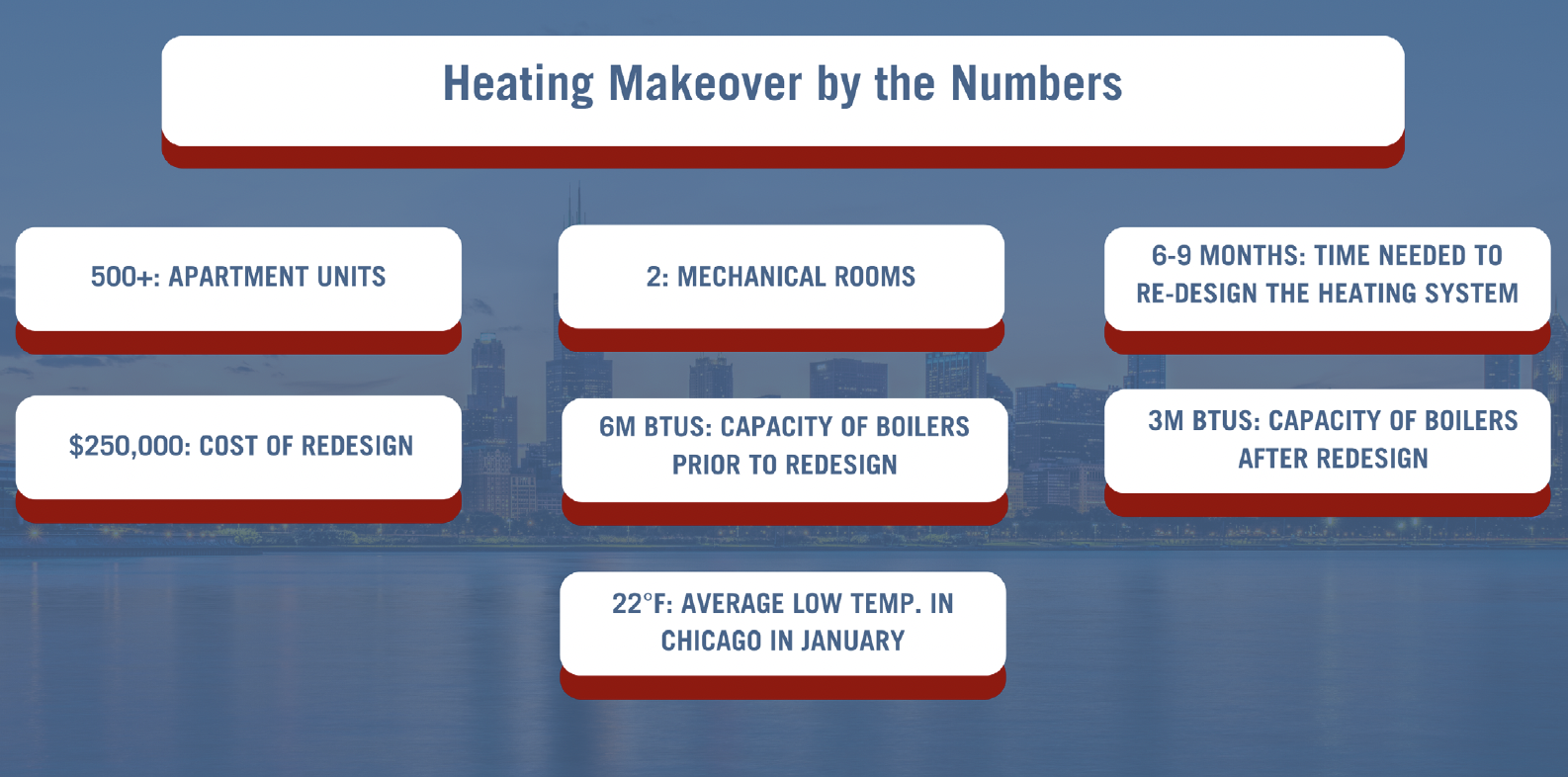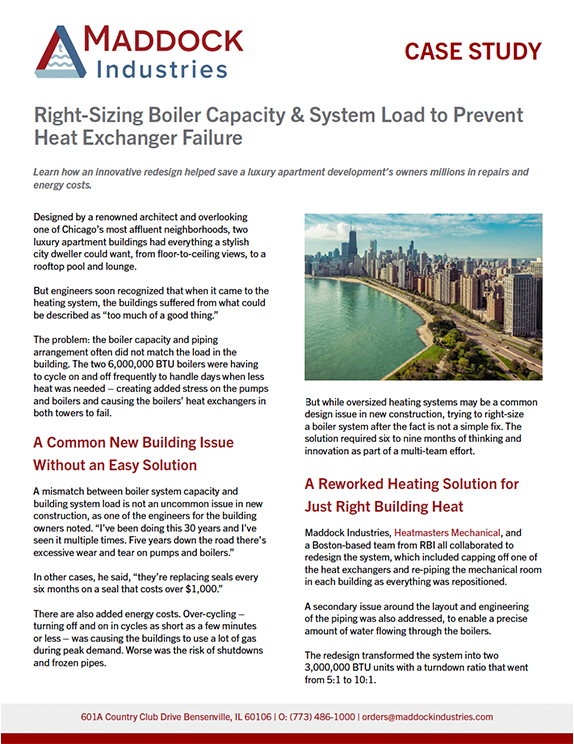Learn how an innovative redesign helped save a luxury apartment development’s owners millions in repairs and energy costs.
Designed by a renowned architect and overlooking one of Chicago’s most affluent neighborhoods, two luxury apartment buildings had everything a stylish city dweller could want, from floor-to-ceiling views, to a rooftop pool and lounge.
But engineers soon recognized that when it came to the heating system, the buildings suffered from what could be described as “too much of a good thing.”
The problem: the boiler capacity and piping arrangement often did not match the load in the building. The two 6,000,000 BTU boilers were having to cycle on and off frequently to handle days when less heat was needed – creating added stress on the pumps and boilers and causing the boilers’ heat exchangers in both towers to fail.
A Common New Building Issue Without an Easy Solution
A mismatch between boiler system capacity and building system load is not an uncommon issue in new construction, as one of the engineers for the building owners noted. “I’ve been doing this 30 years and I’ve seen it multiple times. Five years down the road there’s excessive wear and tear on pumps and boilers.”
In other cases, he said, “they’re replacing seals every six months on a seal that costs over $1,000.”
There are also added energy costs. Over-cycling – turning off and on in cycles as short as a few minutes or less – was causing the buildings to use a lot of gas during peak demand. Worse was the risk of shutdowns and frozen pipes.
But while oversized heating systems may be a common design issue in new construction, trying to right-size a boiler system after the fact is not a simple fix. The solution required six to nine months of thinking and innovation as part of a multi-team effort.

A Reworked Heating Solution for Just Right Building Heat
Maddock Industries, Heatmasters Mechanical, and a Boston-based team from RBI all collaborated to redesign the system, which included capping off one of the heat exchangers and re-piping the mechanical room in each building as everything was repositioned.
A secondary issue around the layout and engineering of the piping was also addressed, to enable a precise amount of water flowing through the boilers.
The redesign transformed the system into two 3,000,000 BTU units with a turndown ratio that went from 5:1 to 10:1.
The new piping configuration also included the installation of a Spirotherm Quad Hydraulic Separator, which in addition to providing a means of dirt and air separation, also enabled the transfer of energy between the primary and secondary systems without one affecting the pressure or flow of the other.
It was a massive undertaking, but one that has left residents – and building managers – sleeping well. Three Chicago winters since the redesign, the heating system remained cozy and efficient. “It’s been fine since the repairs – it’s running normal and there is less wear and tear” on the boilers, the building engineer said.
Heatmasters Director of Engineering and General Manager Nathan Lehmann, whose team proposed the solution of de-rating the boilers, said the project’s success was aided by a full winter’s worth of Chicago temperatures. “We had enough data of what the building needed on bitter cold days,” he said. Today, he said, the system’s cycle has been extended to days, weeks and even months of running time, adding what is likely to be many more winters of life to the boilers.
Peace of Mind & Cost Savings
In addition to peace of mind, the project saved the building’s owners the expense and headache of having to rip out and replace the existing boilers – a cost that could have been as much as 10 times as much as the $250,000 cost of the modifications.
Working with Maddock Industries throughout the repairs kept the project moving smoothly. “They were Johnny-on-the-Spot responding to the boiler issue we had, the building engineer said. In addition to helping to diagnose and solve the issue, Maddock coordinated the participation of the RBI team from Boston, arranged for an extended warranty and helped keep costs down.
“Maddock worked with RBI directly to get them out here from Boston to figure out a solution,” he said. “It was definitely a difficult solution with a new building. It was a huge win to save us a lot of money over the long-term.”
About Maddock Industries
Engineers, mechanical contractors and building owners needing a hydronics partner have relied on Maddock Industries since 1971. The Maddock hydronics experts will help you identify, source, install, and maintain pumps, boilers, valves, and other equipment you need with recommendations for how to maximize space, harness new technology, minimize maintenance costs, and increase profitability in commercial construction projects. Maddock represents Armstrong pumps, RBI water heaters, Garlock Link-Seal, Spirotherm air and dirt separators, Whalen fan coils and water source heat pumps, and more. Maddock specializes in high rises, K-12 schools, colleges, universities, hospitals, government buildings, and food processing plants. More: https://maddockindustries.com
About Heatmasters Mechanical, Inc.
With 70 years of professional HVAC sales and service, Heatmasters has grown from a small family-owned operation to one of the most established, respected and reliable HVAC companies in the Chicagoland area. Through a careful balance of strong customer service, exceptional work, fair honest pricing, and an unmovable commitment to those they serve, they’re proud to be known as a company Chicago truly trusts. More: https://www.heatmastersmechanical.com
About RBI
Offering the most complete and versatile line of finned copper tube boilers available to the commercial boiler market, RBI is the leading manufacturer for domestic or hydronic heating system applications. With models sized to meet today’s toughest commercial challenges, all RBI products are engineered to surpass the highest standards in design and manufacturing – without increasing the cost. More: https://www.rbiwaterheaters.com

